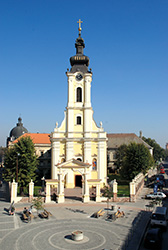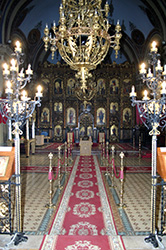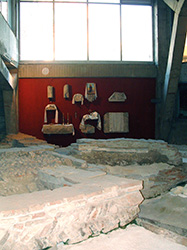Guide
SACRAL HERITAGE OF SREMSKA MITROVICA
Under the Sign of St. Demetrius
Exploiting tourism potentials of Sremska Mitrovica, mainly promoting the offer and service quality, is one of the development priorities of this city. Even in that aspect, the city is unbreakably connected to the saint it celebrates with its name
 The patron saint of (D)mitrovica is Demetrius, highly regarded Christian saint from the IV century A.D. The Serbian church celebrates it on November 8, which is both the Day of the City and the Saint Day in Sremska Mitrovica. Two temples in Mitrovica dedicated to this saint – the basilica and the big city church – are the most visited tourist points of the city. This time we will take a look at both of them. The patron saint of (D)mitrovica is Demetrius, highly regarded Christian saint from the IV century A.D. The Serbian church celebrates it on November 8, which is both the Day of the City and the Saint Day in Sremska Mitrovica. Two temples in Mitrovica dedicated to this saint – the basilica and the big city church – are the most visited tourist points of the city. This time we will take a look at both of them.
BASILICA OF ST. DEMETRIUS
 The settlement in the place of present Sremska Mitrovica was called Sirmium for hundreds of years. The present name of the city is related to St. Demetrius of Thessaloniki. Some scientists even claim that this saint lived in Sirmium, was the deacon of the Sirmium bishop Irinej and together with him died in the persecution of Christians in the early IV century. It is without doubt, however, that the new name of Sirmium originates from the Monastery of St. Demetrius, the most important institution in the Middle Ages in the city, which was then but a shadow of its former glory. The settlement in the place of present Sremska Mitrovica was called Sirmium for hundreds of years. The present name of the city is related to St. Demetrius of Thessaloniki. Some scientists even claim that this saint lived in Sirmium, was the deacon of the Sirmium bishop Irinej and together with him died in the persecution of Christians in the early IV century. It is without doubt, however, that the new name of Sirmium originates from the Monastery of St. Demetrius, the most important institution in the Middle Ages in the city, which was then but a shadow of its former glory.
However, the roots of the cult of St. Demetrius in Sirmium are much older than the monastery. They originate from the V century, between 427 and 441, when Sirmium belonged to the Eastern Roman Empire and when prefect Leontius built the  temple dedicated to St. Demetrius (the Church of St. Demetrius already existed in Thessaloniki at the time.) In time, a very strong cult of this saint developed around the Sirmium temple, so the name of the city was changed in the Middle Ages. Sirmium became the city of St. Demetrius. temple dedicated to St. Demetrius (the Church of St. Demetrius already existed in Thessaloniki at the time.) In time, a very strong cult of this saint developed around the Sirmium temple, so the name of the city was changed in the Middle Ages. Sirmium became the city of St. Demetrius.
People believe that the location of the original Leontius’ basilica, dedicated to Demetrius, was discovered during the archeological excavations in 1978 in the city center, in the present Square of Vojvodina Brigades. It was a three-nave early Christian church, oriented towards the east and the west, 20,5 meters long and 12,5 meters wide. It belonged to the Byzantine sacral architecture. A semicircular seat for the priest was raised along the inner side of the apse. Below the seat was a paved square field.
CHURCH OF ST. DEMETRIUS
 When the Austrians began restoring Mitrovica after they had conquered Srem from the Turks, there was only one Orthodox temple in the city, the present Small Church on the Sava. Due to the increase of the Orthodox population and the dilapidation of the existing church, the Serbs were thinking about building a new one. After forming one of the central streets When the Austrians began restoring Mitrovica after they had conquered Srem from the Turks, there was only one Orthodox temple in the city, the present Small Church on the Sava. Due to the increase of the Orthodox population and the dilapidation of the existing church, the Serbs were thinking about building a new one. After forming one of the central streets in the town, they asked Empress Maria Theresa for approval for building a new church. The approval was granted in the spring of 1777, but the works began only in 1791 because of removing twelve houses around the Parade Platz (present park) and the resistance it provoked. The church was completed and consecrated in 1794. It was originally dedicated to St. Stephen, and only recently to the patron saint of the city, Holy Martyr Demetrius. It was built in the baroque manner, with elements of classicism. It is a single nave church, with a semicircular altar apse on the east and a high bell tower above the west façade. in the town, they asked Empress Maria Theresa for approval for building a new church. The approval was granted in the spring of 1777, but the works began only in 1791 because of removing twelve houses around the Parade Platz (present park) and the resistance it provoked. The church was completed and consecrated in 1794. It was originally dedicated to St. Stephen, and only recently to the patron saint of the city, Holy Martyr Demetrius. It was built in the baroque manner, with elements of classicism. It is a single nave church, with a semicircular altar apse on the east and a high bell tower above the west façade.
The iconostasis, painted by famous Arsa  copy.jpg) Teodorović, is divided into three zones. The first includes the main icons, Annunciation on the imperial door and standing figures of archangels Michael and Gabriel on the side doors. Above the imperial door is the painting of the Last Supper, and above the side doors are St. George and St. Demetrius. The second zone shows Trinity (Coronation of the Virgin) and presentations of Christian holidays, and the third shows the Crucifixion with medallions of the Holy Virgin and St. John the Divine. The original appearance of the altar divider was altered by later works of painters Novak Radonić and Jovan Klauzen. Teodorović, is divided into three zones. The first includes the main icons, Annunciation on the imperial door and standing figures of archangels Michael and Gabriel on the side doors. Above the imperial door is the painting of the Last Supper, and above the side doors are St. George and St. Demetrius. The second zone shows Trinity (Coronation of the Virgin) and presentations of Christian holidays, and the third shows the Crucifixion with medallions of the Holy Virgin and St. John the Divine. The original appearance of the altar divider was altered by later works of painters Novak Radonić and Jovan Klauzen.
|
